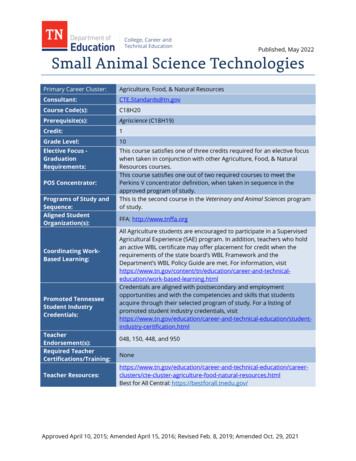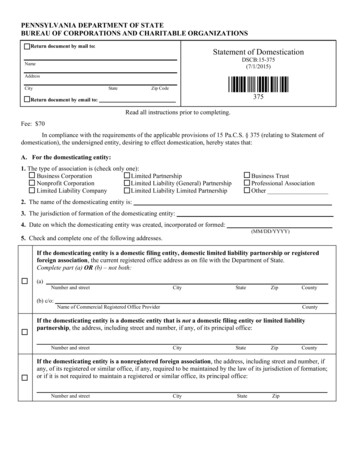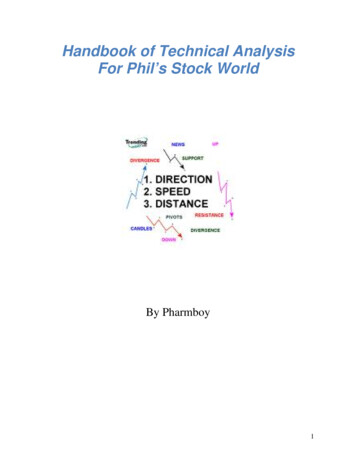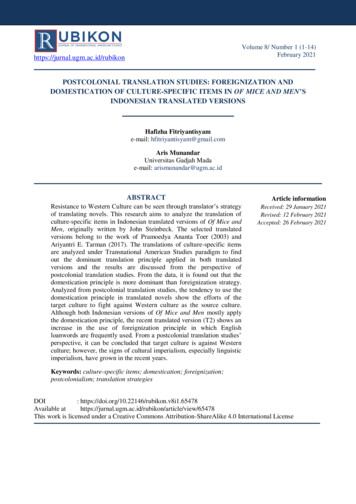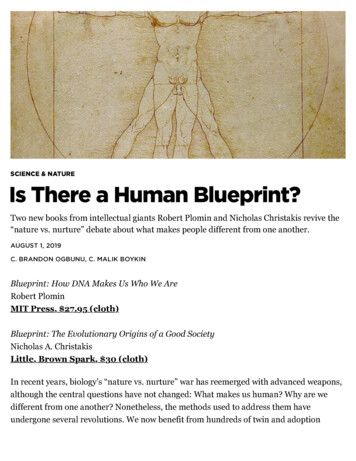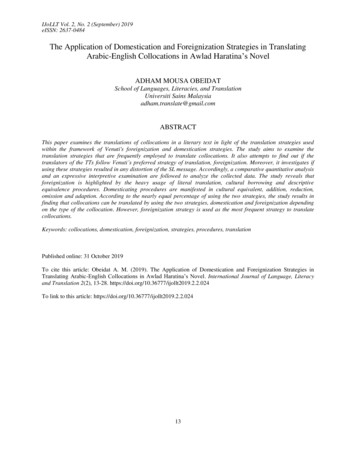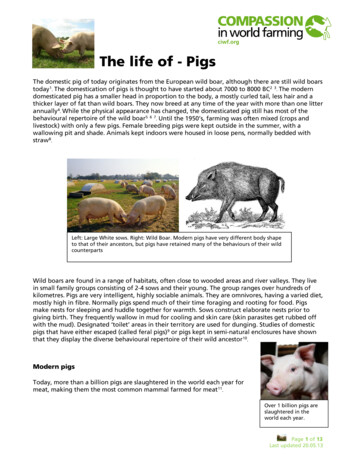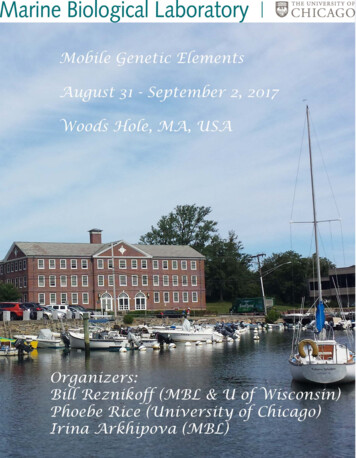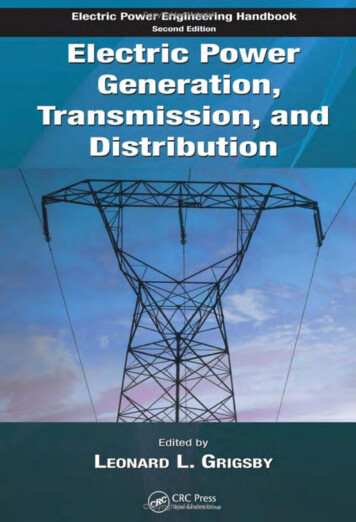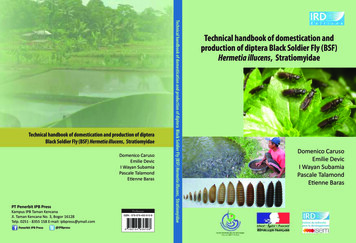
Transcription
Domenico CarusoEmilie DevicI Wayan SubamiaPascale TalamondEtienne BarasPT Penerbit IPB PressKampus IPB Taman KencanaJl. Taman Kencana No. 3, Bogor 16128Telp. 0251 - 8355 158 E-mail: ipbpress@ymail.comPenerbit IPB Press@IPBpressPerikananISBN : 978-979-493-610-8Technical handbook of domestication and production of diptera Black Soldier Fly (BSF) Hermetia illucens, StratiomyidaeTechnical handbook of domestication and production of dipteraBlack Soldier Fly (BSF) Hermetia illucens, StratiomyidaeTechnical handbook of domestication andproduction of diptera Black Soldier Fly (BSF)Hermetia illucens, Stratiomyidae Domenico CarusoEmilie DevicI Wayan SubamiaPascale TalamondEtienne Baras
Technical handbook ofdomestication and productionof diptera Black Soldier Fly (BSF)Hermetia illucens, Stratiomyidae.
Technical handbook ofdomestication and productionof diptera Black Soldier Fly (BSF)Hermetia illucens, Stratiomyidae.Domenico CarusoEmilie DevicI Wayan SubamiaPascale TalamondEtienne Baras
TECHNICAL HANDBOOK OF DOMESTICATION ANDPRODUCTION OF DIPTERA BLACK SOLDIER FLY(BSF) HERMETIA ILLUCENS, STRATIOMYIDAE.Editors:Domenico CarusoEmilie DevicI Wayan SubamiaPascale TalamondEtienne BarasCopyright 2013 Domenico Caruso, Emilie Devic, I Wayan Subamia,Pascale Talamond, Etienne BarasEditor: Dwi Murti NastitiCover Design: Sani EtyarsahLayout Design: Ardhya Pratama, Bambang Dwi SusiloCorrector:PT Penerbit IPB PressKampus IPB Taman Kencana BogorFirst Edition: December 2013Printed by Percetakan IPBProhibitied to quote or reproduce in whole or in part the contentsof this book without permission of Editors.ISBN: 978-979-493-610-8
ABSTRACTThis technical book aims to publish required key information fordomestication and production of the insect Hermetia illucens.Also known as « Black Soldier Fly » (BSF), this cosmopolitandipteran, belonging to the family of Stratiomyidae, is consideredas non-pest.Being saprophagous at the larval stage, it is able to bio degradevarious organic wastes. For years, recycling of domestic oragricultural wastes has been a continual concern and thepotential use of BSF larvae in this field already raised theinterest of many researchers. However, the recent awarenessof the scarcity of food resources for livestock has led French andIndonesian researchers to consider BSF as a new animal foodresource.This is the core of the Bioconversion Project held in Indonesiawhich -through the construction of an experimental pilot- allowedthe mass production of this insect. This book explains how toproduce BSF adults, eggs and larvae for animal –feeding, with aparticular emphasis on fishes. Besides methods of production ofBSF, this technical handbook summarizes the successive stepsof the project in order to specify the potentialities and limits ofusing BSF larvae for feeding fishes in tropical aquaculture.A thorough economic analysis stresses both strong and weakpoints of the pilot and provides elements of decision makingfor producers. BSF productions were mostly obtained whileusing Palm Kernel Meal (PKM) as a substrate. However, othersubstrates have been experimented at different scales toconsider alternative productions.
AbstractThis technical book, which was prepared for a broad audience rangingfrom scientists to producers, sums up knowledge on BSF biology andrearing. So it aims at spreading knowledge and know-how gained duringthe Bioconversion Project.Besides, we hope this handbook will stimulate the readers to act forthe direct or indirect promotion of insects as new food resources formankind.vi
MENTACKNOWLEDGEThe bioconversion project would have been impossible toachieve without beneficial action of many people. Among them,authors wish to warmly acknowledge Mr. Fatuchri Sukadi, from“Balai Riset Perikanan Budidaya Air Tawar” (BRPBAT) thanksto whom the project started in Indonesia. The experimentalpilot in Depok was an expensive research tool. The buildingand operating costs have been strongly supported by IRD –particularly by the “Direction de la Valorisation au Sud” (DVS)as well as by the “Service de Coopération et d’Action Culturelle”SCAC from French Embassy in Indonesia.We also wish to acknowledge every student and worker involvedon a daily basis in the development of research on BSF. Specialthanks go to Mr. Urip who participated to the bioconversionproject since its start.Last but not least, writing this handbook was not a pushover andthe authors wish strongly acknowledge all the colleagues fromIRD/ ISEM for critical comments on early drafts of this manuscript,namely Marc Legendre, Jacques Slembrouck, Rémi Dugué andSophie Quérouil-Carles, who have largely contributed to theimprovement of this handbook. Special thanks to DominiqueCaseau-Baras, for her patient and thorough reviewing of theEnglish style of the manuscript.
CONTENTSABSTRACT. vACKNOWLEDGEMENT. viiCONTENTS . ixINTRODUCTION. xiChapter 1 Biology of Hermetia illucens. 1Chapter 2 Presentation of pilot production. 11Chapter 3 Substrates for rearing. 21Chapter 4 Rearing of adult BSF and egg production. 37Chapter 5 Production of pupae. 51Chapter 6 Rearing of Fattening BSF Larvae. 65Chapter 7 Ecological Intensification of Aquaculture:Perspectives offered by BSF. 77Chapter 8 Nutritional characteristics of Hermetia illucensfor Fish Farming. 89Chapter 9 Economic Aspects of Production. 101CONCLUSION AND PERSPECTIVES. 107REFERENCES. 123GLOSSARY. 137
INTRODUCTIONDemographic evolution, impact of climate change on naturalresources and necessity of their sustainable management,require increasing the global food production by about 70%before year 2050 in order to feed the 9 billion inhabitants theplanet will count by then. The necessity to feed such a growingpopulation generates a constant pressure on both plant andanimal productions. This is especially true in South East Asia,which is the most densely populated region in the world.Industrial rearing of chickens, pigs and fish is in continuousexpansion due to increased consumption by humans. Thisgrowth is intimately dependent on the availability of proteinsources for sustaining animal productions.The production of vegetal protein-rich soybean meal supportsthis demand to a great extent with a worldwide productionof about 124 million tons (United States Department ofAgriculture, 2012). However soybean intensive cultivationhas a strong impact on environment (deforestation, pollution,GMO) and the sustainability of this production remains widelydebated. Fishmeal, with over 4.7 million tons produced yearly,is the main source of animal protein. Animal proteins generallydisplay higher biological value than plant proteins and they aremuch more used to feed fishes in aquaculture.Fishmeal essentially originates from the fisheries of small pelagicfishes, mainly Peruvian anchovies. Tacon and Metian (2008)estimated that 68% of this fishmeal was intended to aquaculturefood. The use of this resource is rightfully questionable.
IntroductionMoreover, the stagnation of wild fish captures, linked to an increasingand endless demand for animal rearing purposes, makes this resourceincreasingly expensive and limited.The availability of food in aquaculture is restrained, more particularlyas regards the sources of protein. Therefore the use of agricultural byproducts and unconventional animals as bioconverters becomes a truenecessity.Although rather anecdotal until now, insect rearing opens heuristicperspectives well beyond the field of animal feeding.According to FAO (2012), no less than 527 species of insects are currentlyconsumed by humans in 78 countries. Most of them are collected in thewild, whereas their rearing in controlled conditions could be much moreadvantageous for many purposes, including their use as protein sourcesfor other animal productions.The Black Soldier Fly is often found in the vicinity of poultry and pig rearingunits where their larvae feed on manure or compost (Furman et al., 1959;Booth and Sheppard, 1984; Newton et al., 2005b). BSF Larvae are ableto utilize massive amounts of organic waste and reduce their unpleasantsmells (Lardé, 1990).They reduce efficiently the accumulation of polluting compounds(nitrogen, phosphorus) from manures and composts. They also modifythe bacterial microflora by reducing the ocurrence or abundance ofundesirable bacteria (Erickson et al., 2004; Yu et al., 2011).Therefore, BSF larvae increasingly emerge as a sustainable alternativemethod for organic waste treatment. Moreover, they are efficientconverters as they produce a protein and lipid-rich biomass from substratesthat can be poorly used by monogastric animals. These characteristics,linked to a short production cycle, make BSF larvae very good candidatesfor intensive production, as far as the domestication and the productionof the insects are controlled.xii
IntroductionInitiated and developed owing to the clear-sightedness of Saurin Hem(French researcher from IRD), the “Bioconversion project”, based on the,recycling of Palm Kernel Meal, PKM) by BSF, is an international project.Originally conceived in Western Africa this project has been deepenedand developed in close cooperation with Indonesian scientists from1BPPKP-Depok .A semi-industrial pilot rearing unit that, as far as we know, has nocounterpart in the world at present, has been developed to performextensive experimentations. It also gave the opportunity to study theproduction of BSF adults, eggs and larvae for animal - especially fishes feeding.This internationally shared research would not have been developedwithout the perseverance of Saurin Hem (IRD) to whom this handbook islargely dedicated.xiii
Saurin was initially concerned with thedevelopment of fish farming in smallvillages in Guinea-Bissau in WesternAfrica, where resources were limited andother ways of rethinking and developingaquaculture were needed. Owing tohis sharp sense of observation, Saurindeepened in studying unidentified larvae hespotted in PKM crop waste (he discoveredshortly thereafter these were BSF larvae)and he wisely anticipated this might be analternative to provide alternative sources ofproteins for fish food. Since then his careerof oceanographer and expert in aquaculture has been indissolublylinked to the Black Soldier Fly. The first productions of BSF larvaewere started with artisanal fish farmers from surrounding villages.Also, as a visionary man, he had foreseen the numerous potentialuses of BSF. Since then, about 10 years ago, he has become a fierceadvocate of BSF, together with the colleagues of his research unit;thereafter IRD and Indonesian partners gave him the opportunity toperform large-scale experiments: the bioconversion project was born.As a tireless master-builder, he has built, expanded and promoted thedomestication and production of BSF in Indonesia, proving relentlesslyto Indonesian decision-makers, students and fish farmers the interestand reliability of domestication and production of this insect. SaurinHem has been and still is an atypical and determined researcher, as hethinks that science has to produce reachable goals in the near future.He made us proud to write this handbook, which is largely dedicatedto him.1BPPKP: Badan Penelitian dan Pengembangan Kelautan dan Perikanan
Technical handbook of domestication and production of dipteraBlack Soldier Fly (BSF) Hermetia illucens, Stratiomyidae.Editors: Domenico Caruso, Emilie Devic, I Wayan Subamia, Pascale Talamond and Etienne Baras IRD-DKP 2013, ISBN: 978-979-493-610-8Chapter 1Biology ofHermetia illucensEmilie Devic(a) and Melta Rini Fahmi(b)(a) UMR 226-IRD (Institut de Recherche pour le Développement)Graha Kapital 1, Jl. Kemang Raya No. 4, 12730 Jakarta,Indonesia.(b) BPPBIH (Balai Penelitian dan Pengembangan BudidayaIkan Hias) Jl. Perikanan No. 13, Pancoran Mas, 16432Depok, Jawa Barat, Indonesia
Chapter 1Biology of Hermetia illucensClassification and DistributionHermetia illucens (Linnaeus, 1758) known as the Black Soldier Fly (BSF)is an insect belonging to the order of Dipterans, family of Stratiomyidae,sub-family of Hermetiinae. The table 1-1 lists characteristic anatomicalfeatures of the species (Table 1-1).Native of tropical, subtropical and temperate regions of the Americancontinent, BSF is nowadays present in the rest of the world, betweenlatitude 40 south and 45 north, and has been found in many countriesacross Europe, Africa, Oceania (Australia and New Zealand) and Asia(Indonesia, Japan, Philippines and Sri Lanka).Table 1-1 Description of anatomical specific features for each subdivision ofclassification according to Martinez (1986), Maddison and era2Specific anatomical featuresArticulated invertebrates and provided withjointed appendagesNumber of legs: 6InsectsTwo pairs of wings: on the second and the thirdthoracic segments, a mandibular joint withcondyles and metamorphosis in the course oftheir developmentCapacity to fold up wings towards the back, onthe abdomenTwo pairs of wings: a pair of functional, flightwings with a membranous structure on themesothorax, and a pair of halteres, derived fromthe hindwings on the metathorax, which help tobalance the insect during flightReduction in the number of flagellomeres(subdivision of the flagellum, last segment ofthe antenna of arthropods) in 8 or less. Larvalmandible formed by two distinct parts.
Biology of Hermetia illucensChapter 1Table 1-1 Description of anatomical specific features for each subdivision ofclassification according to Martinez (1986), Maddison and Schulz(2007) (return)ClassificationKingdomAnimaliaSpecific anatomical featuresFamilyStratiomyidaeSpecific nervation of wings with formation of adiscal cellSub-familyHermetiinaeEighth antennal flagellomeres long and thick andabsence of spine on the scutellum (plates at theback of the 2nd segment of the thorax)GenusHermetiaEighth antennal flagellomeres flattened laterallyHermetiaillucensVery long antennae due to the exceptionallengthening of the last article of the flagellum.Abdomen with, on its 2nd segment, a pair oftranslucent mirrors. Smoky black wings. Largevery characteristic species, 12 - 17 mm.SpeciesHuman migrations and trade of goods have contributed to its dispersion(James, 1935; Leclercq, 1997). This insect, considered as non-pest,does not appear in the list of disease carrying organisms or vectors forpathogens.Some cases of myiasis caused by larvae of H. illucens have been reported(Adler and Brancato, 1995; Lee et al., 1995; Fuentes Gonzales and RiscoOliva, 2009), but are just exceptional.AnatomyHermetia illucens is a holometabolous insect: the transition from the larvalstage to the adult stage happens following a passage through a nymphalstage. Transformation is complete, and larvae and adults have contrastingmorphologies and life habits. Larvae are saprophagous and photophobic(Everest Canary, 2009): they live and feed on organic matter (animal orplant) in decomposition (James, 1935).3
Chapter 1Biology of Hermetia illucensTheir cephalic capsule is separate from their body; their strong mouthpartsserve eating purposes but also contribute to their locomotion. The larvalbody comprises 11 segments covered by hairs and bristles. Its colour isbeige or light brown until pupation, thereafter it turns to dark brown.Larvae can reach up to 20 mm in length and about 6 mm in width (Figure1-1).Figure 1-1 Eggs and larvae of Hermetia illucens in the process of theirdevelopment (from 1 to 20 days). Chromatic differences until the17th day are a photographic artefact. On the other hand, the colourshifts from beige to dark brown from day 17 onwardsAdults measure from 13 to 20 mm in length,they possess two long antennae, a singlepair of well developed wings (when at restwings are folded up to one on the other), ashind wings are tiny (halteres, as in alldipterans), and three pairs of legs with awhite/yellow tarsus (Figure 1-2). Males aresmaller than females (Tomberlin et al.,2002) and an anatomic difference on thelast abdominal segment enables toFigure 1-2 Adult BSF flydiscriminate between genders. Femalespossess a retractile tubular oviduct whereas males exhibit an aedeagus(male insect reproductive organ) and a pair of hooks which enable him tograsp the female genital organ during copulation (Figure 1-3).4
Biology of Hermetia illucensChapter 1Figure 1-3 BSF Female genitalia (left) and BSF male genitalia (right)Life CycleThe BSF life cycle varies between populations (wild or domesticated) andenvironments (temperature, humidity, light intensity, quality and quantityof available food). The females lay between 320 and 1000 eggs, on a drysubstrate in a humid environment (to limit the water losses of their eggs)using their ovipositor (Olivier, 2004; Kim et al., 2008; Tomberlin et al.,2009).Eggs are laid into tight rows, generally in an interstice to hide them frompredation and close to a potential food source. BSF females lay their eggsclose to those of other individuals, and they die soon after oviposition(Tomberlin et al., 2002). Eggs have an ovoid shape, and are about 1 mmlong. They change from beige to yellow/beige colour during the incubationperiod, which lasts from a little bit more than 4 days, at 27-29 C (Boothand Sheppard, 1984) to about 3.5 days at 30 C (Tomberlin and Sheppard,2002).5
Chapter 1Biology of Hermetia illucensFigure 1-4 Life cycle of BSFAs soon as larvae have hatched (0.66 mm long), they use surroundingorganic matter as a food source. The duration of the larval stage lasts from4 weeks to 5 months, depending on food availability (Furman et al., 1959).Temperature is also a key parameter for larval development and survivalrates, the optimum temperature being in the 20-30 C range (Tomberlin etal., 2009; Everest Canary, 2009). The growing larvae perform successivemoults that separate five larval stages. They reach successively the pupathen the imago stage following the imaginal moult.Morphologically, the first four larval stages are difficult to differentiate(except for body size) but the prepupal stage (5th larval stage) is6
Biology of Hermetia illucensChapter 1characterized by a marked colour change from beige to dark brown, amigration out of substrate (made easier by a modification of mouth organsin hooks), as old larvae cease feeding prior to pupation (Schremmer, 1986;Diener et al., 2011). The last stage refers to pupae, which are 12 to 25mm long (May, 1961 in Tomberlin, 2001; Hem et al., 2008; Rachmawati,2010). They lie motionless; their cuticle is rigidified and rich in salts ofcalcium forming a dark envelope.Generally, the metamorphosis is completed within 2 weeks (Furman etal., 1959) and males often emerge earlier than females (Tomberlin et al.,2002; Kim et al., 2008). After emergence, young adults take off after fewminutes, after they have unfolded their wings. BSF is an eurygamous insect,as a consequence, it needs broad areas for its nuptial flight). Mating takesplace about 2 days after the emergence of the imago (Tomberlin, 2001;Tomberlin et al., 2009; Tomberlin and Sheppard, 2002), and another 2days are needed before egg laying. An imago lives only 5 to 14 days, its lifeexpectancy being unquestionably dependent on body size (and associatedenergy reserves) and on access to water (Tomberlin et al., 2002; Olivier,2004; Tomberlin et al., 2009).Physiology and FeedingBSF adults do not need feeding as they largely live on the energy reservesbuilt during the larval development (Newton et al., 2005a, b), but thesesupplies can be supplemented by nectar. However, the environmentalfactor that intimately governs their life expectancy is the access to water:adults having access to water may live up to 14 days, whereas thosedeprived of water hardly survive more than 8 days (Tomberlin et al.,2002).BSF larvae are voracious until 21-24 days after hatching. The substratein which they live is saturated with water, so dehydration is reduced andthe access to food is straightforward. However, if the substrate becomesexcessively humid, larvae tend to go away. Their feeding activity reducesthe volume of organic matter by 40 to 80% (Diener, 2010) and strongly7
Chapter 1Biology of Hermetia illucensimpacts the substrate’s content in nitrogen and phosphorus. BSF larvaeare not cannibalistic.Digestion – Enzymatic and Bacterial SystemBSF larvae are polyphagous. This polyphagia, which enables them to makethe most of many food sources, largely owes to their powerful mouthpartsand efficient enzymatic activity of their digestive system (gut and salivaryglands). It is especially in the intestine that enzymes such as amylases,proteases and lipases are most active. Other enzymes such as leucinearylamidase, α-galactosidase, β-galactosidase and α-mannosidase, notpresent or poorly active in domestic fly Musca domestica, are stronglyeffective in BSF larvae (Kim et al., 2011).Besides, BSF larvae host an intestinal flora that takes an active part inthe digestion of food. The identification by pyro-sequencing of bacterialcommunities of BSF larvae’s intestine has provided evidence for aspecific intestinal flora, which largely differs from those documented inother insects. This flora comprises four phyla (Bacteroidetes, Firmicutes,Proteobacteria and Gammaproteobacteria) in variable proportions,depending on food sources. Among these bacterial communities, somestrains or species have a substantial enzymatic activity (protease, amylase,cellulase, lipase), such as Bacillus amyloliquefaciens, B. stratosphericusand Proteus mirabilis (Jeon et al., 2011).BehaviourUsually, adults BSF are found near places where manure, decaying food ordead animals are abundant. Smells from decaying organic matter attractfemales that are ready to lay eggs, whereas males prefer sunny placeswhere vegetation prevails (Figure 1-5). Also, males are strongly territorialin that they defend their area against other males until mature females insearch of a mate pass nearby (Tomberlin and Sheppard, 2001).8
Biology of Hermetia illucensFigure 1-5Chapter 1Adult of BSF on Sphagneticola sp. Notice highest BSF density onsunny leaves.The life of a BSF imago being very short, mating takes place no more than2-3 days after emergence. Mating is exclusively diurnal and comprisesseveral steps: first the male grabs a female flying over its resting area withits legs and hooks of the aedeagus, then male and female will performa courtship flight which can lead them up to 1.5 m above ground levelwhere copulation starts (Tomberlin and Sheppard, 2001). Thereafter,they return to ground level, for 20 to 30 minutes, and continue forming apair, but here male and female look in opposite directions (Figure 1-6).Reproduction steps are governed by environmental conditions and bytime of the day (Tomberlin and Sheppard, 2002); in particular, illuminationand space availability are crucial during mating (Tomberlin and Sheppard,2002; Kim et al., 2008; Zhang et al., 2010). The oviposition depends9
Chapter 1Biology of Hermetia illucensmainly on the temperature (optimum from 27.5 C to 37.5 C; Booth andSheppard, 1984) and on humidity (30 to 90%; Sheppard et al., 2002).Current knowledge of the biologyof BSF provides a frameworkfor starting their rearing incaptivity, but it largely remainsfragmentary to many respects, inparticular for quantitative issuesthat are central to production.The experimentation of thepilot production has resulted inFigure 1-6 Copulationsignificant progress in the processof domestication but it also raised several biological and technical issuesfor which the answers will enable the optimization of BSF rearing.10
Technical handbook of domestication and production of dipteraBlack Soldier Fly (BSF) Hermetia illucens, Stratiomyidae.Editors: Domenico Caruso, Emilie Devic, I Wayan Subamia, Pascale Talamond and Etienne Baras IRD-DKP 2013, ISBN: 978-979-493-610-8Chapter 2Presentationof pilot productionDomenico Caruso(a), I Wayan Subamia(b)(a) UMR 226-IRD (Institut de Recherche pour le Développement)Graha Kapital 1, Jl. Kemang Raya No. 4, 12730 Jakarta,Indonesia.(b) BPPBIH (Balai Penelitian dan Pengembangan BudidayaIkan Hias) Jl. Perikanan No. 13, Pancoran Mas, 16432Depok, Jawa Barat, Indonesia.
Chapter 2Presentation of pilot productionSchematically, production is structured into two main sections: “productionof adults and eggs’’ on the one hand, and “grow-out of larvae” on theother hand. These two sections are interdependent, but they take placeinto two physically distinct structures, namely the insectarium and thelarvarium (Figure 2-1).Figure 2-1 Rearing facilities for BSF in Depok (Indonesia). Larvarium (left);Insectarium (right)It is indeed indispensable that parents be separated from the larvarium,otherwise adult females would be strongly attracted by the productionsubstrates and would lay their eggs anarchically, thereby complicatingstrongly egg collection and overall production management.Thus, the larvarium is devoted to the grow-out of larvae and to theproduction of pupae, a part of which being transferred into a pupariuminside the insectarium to ensure the periodic renewal of broodstock. Theinsectarium is dedicated to reproduction and collection of eggs, whichare transferred to the larvarium for a new cycle of production of larvaeand production of pupae. It is important to underline that the larvariumand the insectarium in Depok were built from existing structures, therebyimposing structural constraints upon their design. If they had been builtfrom scratch, their design would have been different.Other structures used in the process of BSF production, such as theplace to store PKM, are not described here but are taken into accountin the calculation of investments (chapter 9). The different stages of theproduction process that have been performed in the production pilot atDepok are detailed in Figure 2-2.12
Presentation of pilot productionChapter 2Figure 2-2 Diagram of the production systemLarvariumThe larvarium building occupies a surface area of 165 (15.6 x 10.6) m2with an average height of 2.4 m. Pillars in reinforced concrete (30 x 30 x100 cm) poured into the ground (Figure 2-3a) hold metal profiles with arectangular (10 x 5 cm) section. The lower ends of these metal profiles arefitted and welded into another slightly larger piece of metal profile, andfurther affixed to a metal plate that is bolted on the pillar (Figure 2-3b).Load-bearing metal bars are bolted on the top of pillars. They form theroof framework (Figure 2-3c).13
Chapter 2Presentation of pilot productionThe roof has a single slope: it is made of corrugated iron covering a 5-mmthick insulation material that is screwed onto the roof framework toreduce temperature variations.Figure 2-3 a) Detail of the foundations of larvarium and of insectarium; b) baseof metal section of a pillar c) upper section of the pillar supportingthe metal section that makes the framework of the roof. To note tothe left the wire mesh of the roof and to the right the polycarbonatestructure (Insectarium) d) double wire nettingThe walls are made of concrete blocks covered by cement in their lowerpart (1 m above the ground), whereas the upper part is made of twotypes of wire mesh set next to each other. The first one, a large wire mesh(mesh size: 4.5 x 2.2 cm) is welded to corner irons that are bolted onthe horizontal metal bars set between the concrete pillars, and serves tostrengthen the structure. The second one is a fine wire mesh (mesh size: 5x 2 mm: Figure 2-3d) that prevents the entrance of harmful insects.14
Presentation of pilot productionChapter 2This method of building guarantees a good ventilation of the larvarium,which is just indispensable as substrate fermentation produces heat. Thefloor of the larvarium is made of rough polished cement on which arebuilt the “digesters”.Here, digesters are made of blocks covered by cement (they werepreviously used as fish rearing tanks). Every rearing tank has a circularshape, with a diameter of 3.2 m (surface area of 8 m2) and is 0.5 m inheight. It includes a water inlet equipped with a flowmeter to measurethe water volume used during the rearing cycle, which runs until larvaebecome pupae (Cf. Chapter 5). An additional rectangular tank has beenbuilt around every circular digester, so the overall surface of pupaproduction has been increased from 48 to 128 m2 (about 75% of theground surface) (Figure 2-4). The remaining part of the area is made ofcorridors and working zones.Figure 2-4 Inside view of larvariumThe other part of the larvarium is dedicated to the mass production oflarvae to be used as live food for fish. It includes 4 rectangular (4 x 1 m)tanks in polyester resin reinforced by glass fibre and covered with gelcoat.15
Chapter 2Presentation of pilot productionIn contrast to the digesters, which were built from existing structures,these tanks were designed for BSF mass production.They rest on metal supports that are protected from oxidation due tohumid soil by cement blocks. In order to save space, they were set acrossthe rectangular tanks used as digesters and the corridors.Ins
latitude 40 south and 45 north, and has been found in many countries across Europe, Africa, Oceania (Australia and New Zealand) and Asia (Indonesia, Japan, Philippines and Sri Lanka). Table 1-1 Description of anatomical specific features for each subdivision of classification according to Martinez (1986), Maddison and Schulz (2007)
